The Samsung Galaxy S7 and S7 edge Review: Part 2
by Joshua Ho on July 5, 2016 8:00 AM ESTCamera Architecture and UX
In general, camera has become probably the single biggest point of differentiation between smartphones at this point. As smartphones are often the only camera that most people carry on a day to day basis, the rear camera on a smartphone really cannot be a disappointment relative to the competition. While we can talk about how much a front-facing camera matters in terms of quality, it’s pretty safe to say that for photos and videos that are worth saving will be taken with the rear-facing camera.
While post-processing and a number of other factors are going to have a huge impact on the overall camera experience, the foundation that makes it possible to deliver a great camera is always going to start at the hardware.
| Samsung Galaxy S Cameras | ||||
| Galaxy S6 Galaxy Note5 |
Galaxy S7 | |||
| Front Camera | 5.0MP | 5.0MP | ||
| Front Camera - Sensor | Samsung S5K4E6 (1.34 µm, 1/4.1") |
Samsung S5K4E6 (1.34 µm, 1/4.1") |
||
| Front Camera - Focal Length | 2.2mm (22mm eff) | 2.1mm (21mm eff) | ||
| Front Camera - Max Aperture | F/1.9 | F/1.7 | ||
| Rear Camera | 16MP | 12MP | ||
| Rear Camera - Sensor | Sony IMX240 Samsung S5K2P2 (1.12 µm, 1/2.6") |
Sony IMX260 Samsung S5K2L1 (1.4 µm, 1/2.6") |
||
| Rear Camera - Focal Length | 4.3mm (28mm eff) | 4.2mm (26mm eff) | ||
| Rear Camera - Max Aperture | F/1.9 | F/1.7 | ||
In the case of the Galaxy S7, Samsung has done something that I thought they’d never do, which is move backwards in resolution in order to improve pixel sensitivity. In the case of the Galaxy S7, Samsung has moved from the Sony IMX240/Samsung S5K2P2 to the Sony IMX260/Samsung S5K2L1 sensor, with a 1.4 micron pixel size relative to a 1.12 micron pixel pitch in the previous generation. This means that there’s a 56% increase in sensitivity per pixel. Assuming the same process technology, this does improve low light performance significantly. While to some extent it’s true that improved CIS (CMOS image sensor) technology can alleviate the downsides of smaller pixels, on the same technology you have to reduce your fill factor/active sensor area. The other problem is that while read noise on the sensor does reduce per pixel as you reduce pixel size, the overall sensor read noise trends upwards. This means that the region in which the CIS noise is primarily limited by shot noise is going to be smaller as you reduce pixel size. Shot noise is an unavoidable reality of existence, to the extent that even our eyes can see this “visual snow” if ambient light is sufficiently dim.
However, in the case of the Galaxy S7 I suspect that there’s more to the story, because the dual pixel AF system means that for each 1.4 micron pixel each pixel needs two photodetectors. In order to make phase detection work, there has to be sufficient spatial separation to make this system work properly, so some of the benefit of these larger pixels will inevitably be eaten up in order to enable PDAF that works in basically all lighting conditions.
The other notable change here is that the Galaxy S7 uses an even wider f/1.7 aperture. Unfortunately, in Samsung's efforts to try and make the module thinner they've made the focal length slightly shorter than before which results in an effective focal length of 26mm. This and the wider aperture could lead to compromises as light is entering the optics at a more extreme angle than before.
With these basics covered, we can move on to a discussion of the user experience. While in the past it was easy enough to just take some still shots on a tripod, a holistic view of camera quality really needs to take into account far more than just the end result. A poorly designed camera application with low resolution, low frame rate preview, improper preview aspect ratio, poor control layout, and other issues can easily make it difficult, if not impossible to get the photo that you want. These issues are thankfully getting less common, but these problems can make it almost impossible to recommend a phone for its camera, no matter how good the results are.
In the case of the Galaxy S7, the camera application is a nice upgrade over the Galaxy S6 at launch, but for the most part nothing is really different this go around. I’m not going to spend too much time here, but the short story is that I don’t think that Samsung is doing anything wrong here, and things are pretty much as good as they’re going to get.
While leaving it at that would be enough, I want to recognize some of the improvements that Samsung has implemented here. The major improvement here is that Pro mode is finally useful, as this mode now allows for adjusting auto-exposure and AF targets, in addition to EV, shutter speed, ISO, white balance with 100K granularity, and manual focus. The one notable shortfall here is that Samsung only allows 800 ISO max in manual ISO mode when the true maximum is 1250. For better or worse though, that’s the only notable problem I encountered with the camera app itself. It’s easy to think that Samsung hasn’t done anything notable here, but this is more a testament to the execution of design more than anything else.
However, before we move on to image quality testing, we can take a look at our focus and capture latency tests. For those that are unfamiliar, this is a fairly simple test designed to see how long it takes for a phone to focus and capture a scene on our standard ISO test chart in good lighting conditions, which can give a fairly good idea for best case latencies.
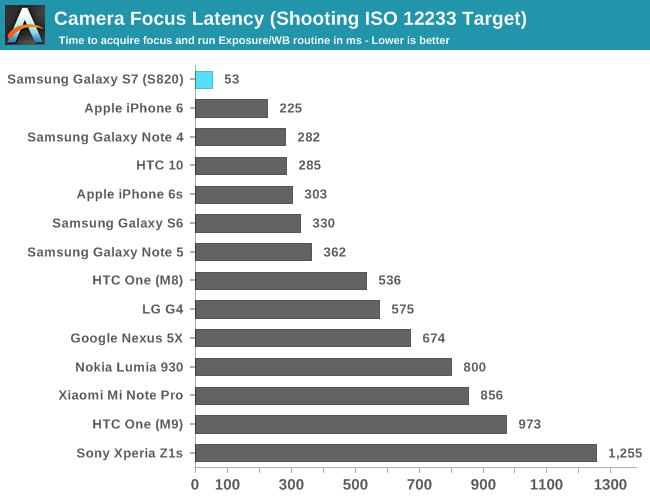
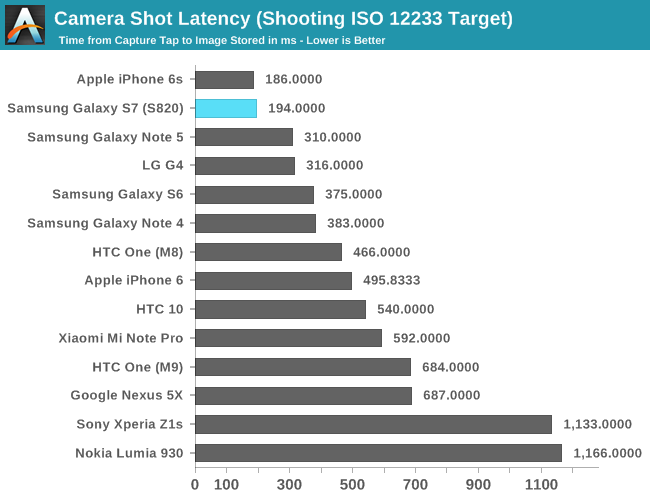
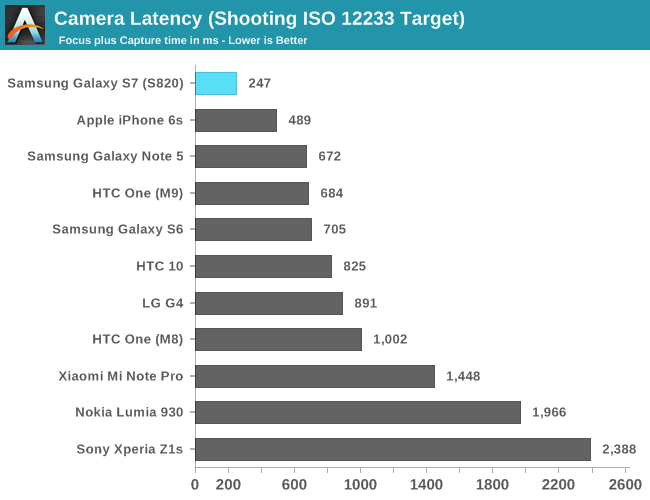
It’s probably not a surprise, but the Galaxy S7 is really, absurdly quick to take photos and focus. There is nothing out there that can realistically match the dual pixel AF system in the Galaxy S7, especially once you get into low light scenarios where traditional PDAF systems are overwhelmed by noise that can’t be easily canceled out. Samsung’s sheer prowess in semiconductor design and manufacture is really showing here, even in the best case.


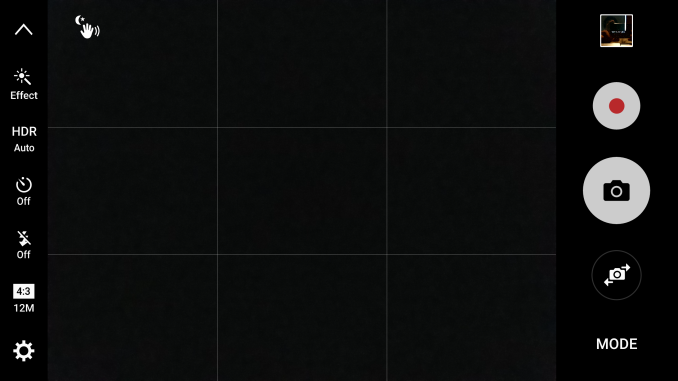
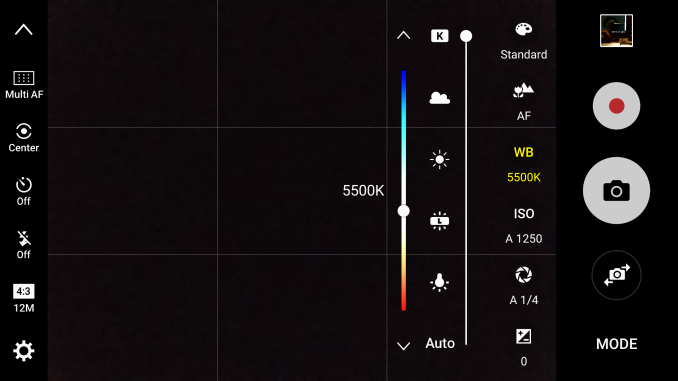
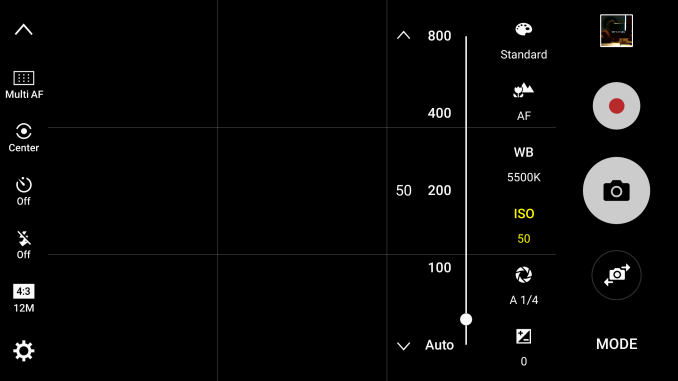








266 Comments
View All Comments
virtuastro - Wednesday, July 6, 2016 - link
Exactly. My friend bought the S7 for the camera. We tested together between the S6 16mp F/1.9 (my phone) and S7 F/1.7 12mp 1.4 µm. Autofocus is indeed faster on S7 than the S6. Still Image quality and Low-Light still better on S6 for the most part. The LG G4 and G5 both still use 16mp and great in low-light as well. I am not going to upgrade GS7 but waiting for next year. Hopefully Samsung need to back at 16mp F/1.7 to F/1.9 might add more faster autofocus. P.S. English is not my first language.lilmoe - Wednesday, July 6, 2016 - link
Provided sensor technologies are similar, the size of individual photosites don't matter really, what ultimately matters is the size of the sensor (the total amount of light captured) and the speed of the lens.Lower resolution images are better for faster and more fine-tuned post processing.
Impulses - Thursday, July 7, 2016 - link
Buying any high end phone largely on the basis of it's camera, particularly if you already have a decent 1-2 yr old flagship phone, is a huge waste of money IMO. The same kind of money gets you so much more in a dedicated camera, whether it's a P&S, DSLR, or compact mirrorless ILC.Smartphones killed low end small sensor P&S cameras, that market was essentially gutted (and with good reason as it was quite stagnant), but they're still far far behind anything else.
beginner99 - Wednesday, July 6, 2016 - link
"There are clear points of differentiation between the Galaxy S7 and OnePlus 3 or Mi5 in terms of features, but I don’t think it’s enough to be worth the $300"True but it's war from $300 if you look at real prices at which you can buy the phones especially international version. I was very interested in the Mi5 but now that it is finally available here much less so. The 64 GB variant is about $30 cheaper than the 32 gb S7 (international). The later however is water-proof, has an sd-slot and more importantly also more LTE bands, better screen and camera plus it's less risk in general and higher resale value because Samsung. (The 32 gb mi5 has a slower SOC). Even though it kind of hurts me to go Samsung which everyone else has here that doesn't have an iPhone, it's the phone that suits me best. What also concerns me, is that benches you show here don't show the whole truth. Look at below comparisons. The S7 is just way faster in real-life:
https://www.youtube.com/watch?v=vR2zq5I3i4g
tansnhands66 - Wednesday, July 6, 2016 - link
I never had the 6 but there were a lot of little things I miss from the 5 and the Note Edge. Texting lost a lot like no delayed sending, no "send now" on scheduled texts, no editing scheduled texts,and no repeat timed notification reminder . And for the calendar, no timed snooze setting (10,15, etc. minutes) and no "go to date" option. And don't get me started on the ONLY tone for the timer. It sounds like "Bedonkadonk, Bedonkadonk". Very annoying.Meteor2 - Wednesday, July 6, 2016 - link
For some reason I decided to read the comments before the article and... are we reading the same review? Joshua, this is a well-balanced, accurate and fair review. I don't like iOS but bottom line is top-drawer Android is well behind Apple. I love my Nexus 5X for its display, UI, and value. Flagship Android phones are poor value right now.KoolAidMan1 - Sunday, July 10, 2016 - link
Anandtech always has been and remains one of the most unbiased, objective sites out there.Some people see that a GS7 gets BTFO by even the iPhone SE and their brains break. It just doesn't compute that "Crapple" continues to deliver with the best hardware so they have temper tantrums and call AT biased shills.
Its so childish. If these people would use empirical data instead of their personal emotional bias they might learn something.
darkich - Wednesday, July 6, 2016 - link
"when themes can have noticeable effects on performance and battery life".. WHAT KIND OF BS IS THIS, AT!?!?Michael Bay - Wednesday, July 6, 2016 - link
Surprised by this?Try using your head then, it helps.
darkich - Wednesday, July 6, 2016 - link
Oh really..Themes affect the performance and battery life in such minor extent that pointing it out on a supposedly the most professional tech site is utterly ridiculous.
I used themes on my phone since Symbian OS! And even then the effect on battery endurance and performance has been unnoticeable.